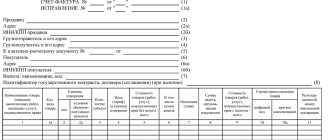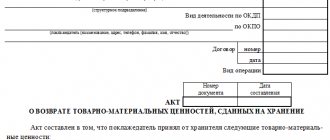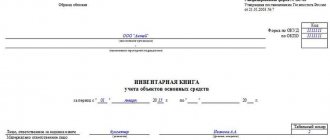Any receipt of goods must be documented with the appropriate primary document. The State Statistics Committee of Russia has developed a unified form TORG-1, which should reflect the receipt of material assets according to quantitative and cost estimates. The act of acceptance of goods is confirmation of shipment in accordance with contractual obligations. Responsibility for the timely and correct execution of such a primary document lies with the members of the commission appointed by the head of the company. In the article we will tell you about TORG-1 Certificate of Acceptance of Goods, and we will provide a sample for filling it out.
Filling out the TORG-1 form
The obligation to fill out the unified TORG-1 form occurs upon the actual receipt of inventory items. The responsible person checks the completeness, quality and quantity with the information specified in the form. If inconsistencies and disagreements arose during acceptance, then such facts are reflected in the TORG-2 and TORG-3 acts. The act of acceptance of goods is controlled by a commission appointed by the head of the enterprise.
The TORG-1 form has a title header, a tabular part and a final section, which reflects the comments of the responsible persons and their signatures.
The title part of the document reflects the following information:
- Full name of the company;
- Details of the document on the basis of which the goods acceptance certificate is drawn up;
- The structural unit where goods are received;
- Information about primary accompanying documents (waybill, invoice);
- Information about the shipper (this information is especially important if the manufacturer and supplier are not the same person);
- Method of delivery of goods. This line indicates what type of transport the goods were delivered (by train, refrigerator, ship). If violations were committed during the transportation of valuables, then such goods may not be accepted according to the act.
- For food products subject to veterinary inspection, the date and number of the certificate received are entered.
- If the goods were insured, then the information of the insurance company is reflected in the form;
- Temperature conditions for products to be refrigerated;
- Date of arrival of inventory items.
The second section of the form lists the entire range of goods received, its quantity, weight and cost indicated in the supplier’s accompanying documents. Certification information is also provided for the product. The third section reflects actual data on the availability, quantity and weight of goods. The VAT tax rate and its amount are reflected in a separate column.
If various inconsistencies were discovered during the acceptance process, they are also recorded in the tabular section in the “Deviations” section. Moreover, negative values are reflected with a minus sign. The fourth page of the TORG-1 form contains the conclusion of the selection committee and the signatures of the responsible persons.
If a discrepancy is identified, an explanatory note is made in the form, on the basis of which the head of the company makes his decision on taking the necessary measures. A careful assessment of the received goods, as well as the entry of identified deviations, will become documentary evidence in the event of a dispute with the supplier.
When is a goods acceptance certificate drawn up?
It is recommended to conclude an act of acceptance of goods every time there is a transfer of some product or its exchange. It is concluded between business entities. These agreements are especially in demand between two organizations in which there is a large trade turnover. They regulate relationships between subjects and serve as an evidence base in case of disagreement.
Attention! The act of acceptance of goods is raised when conflict situations arise between business entities. They serve as arguments for the correctness of one of the parties if disagreements are resolved in court. It is the document that serves as significant evidence.
TORG-1 is used by organizations together with accompanying documents. These can be invoices , as well as TTN or invoice . It is stamped with the “host” entrepreneur’s stamp. But there is no need to create a new one every time.
The differences concern the accompanying documents. For example, if TORG-12 , then it regulates not only the number and name of products, but also write-off from the one who sent it, and registration from the one who accepted it. Also, such accompanying documentation regulates the quality, configuration and other characteristics of the product. Taking these factors into account, it becomes clear that drawing up TORG-1 does not always pay off - all the necessary information is in another document. But the TORG-1 acceptance certificate will be drawn up necessarily in the following cases:
- If this is provided for by the charter of the enterprise, the peculiarities of the document flow imply its mandatory preparation;
- If upon acceptance some defects in the product are discovered that are not listed in additional documents, in addition to one copy, a statement of the identified discrepancy is also drawn up, signed by both parties.
If there are discrepancies in the documents of organizations, then an acceptance certificate is also drawn up. It spells out these nuances. If one of the parties has any claims, this document can serve as evidence in court.
How to correctly fill out a goods acceptance certificate
In order to avoid disputes with counterparties and tax authorities, the act of acceptance of goods must be drawn up in accordance with the law. For example, this is especially important when confirming the validity of the deduction of input VAT.
An incorrectly completed TORG-1 form may serve as a reason for refusing to reduce the budget payment.
In order to correctly draw up a document, you must follow the following rules:
- All columns related to a specific item must be filled out.
- The document must be signed by authorized persons.
- If the supplier is a person exempt from the accrual and payment of VAT, then this fact must be noted in the contract.
- When drawing up the act, it is necessary to check the availability of a veterinary certificate, invoice, and delivery note.
If an incorrect completion of the act was discovered, it must be redone. Particular attention should be paid to signing the document. Quite often, a facsimile signature is used in accounting documents, which is not always approved by the tax authorities. In accordance with Art. 160 of the Civil Code of the Russian Federation, such endorsement of documents is quite acceptable, but in order to avoid a conflict situation with regulatory authorities, such documents are not recommended to be taken into account.
How to draw up for the reception and transfer of material assets
The next option is the transfer of property within the organization: from one financially responsible person (hereinafter referred to as the MOL) to another or from the organization to an employee. In this case, it is necessary to draw up a document. This can be done in any form with the obligatory indication of the date of the procedure, the name of the items of transfer, their quantity and the persons to whom the values are transferred. If the transfer occurs from one MOL to another, new one, then an agreement on individual (or collective) financial responsibility must be signed with the second one. One copy is at the MOL, the second is in the accounting department.
The transfer of material assets for temporary storage should be formalized with paper confirming that the inventory assets have been transferred for storage. For this purpose, a unified form MX-1 has been created (OKUD code 0335001), which is not mandatory for use, but is very convenient to use, therefore it is widely used in budgetary organizations.
Is it possible to change the unified form of the act?
Until recently, it was possible to accept goods only using the unified TORG-1 form. With the entry into force of Federal Law No. 401-FZ, the rules for preparing primary documents have changed. Now companies have the right to independently develop convenient forms of documents that will best suit the specifics of their business. According to accounting rules, samples of such forms must be included in the accounting policy of the enterprise.
Mandatory and optional document details:
| Mandatory | Optional |
| Form name, date and document number | Shipping method |
| Name of company | Availability of a veterinary certificate |
| Product range, quantity | Information about the insurance company |
| Signatures of officials | Place of goods acceptance |
The finalized act of acceptance of goods will have legal force only if all required details are present.
Rules for document preparation
On the first page, fill in information about the consignee:
- Name;
- OKPO code;
- OKDP code;
- location.
After this, fill in the place of acceptance of the goods (for example, the address where the warehouse is located) and the details of the accompanying document (for example, a delivery note). Please indicate below:
- names and addresses of the shipper, consignee and supplier;
- details of the contract and invoice (if any);
- delivery method (for example, by road);
- date, time and place of departure of the cargo.
The second page contains information about discrepancies. The first table indicates the shipper's data (information about the condition of the transport, presence of sealing marks, name of the goods, quantity and gross weight.
The second table is filled in if there are discrepancies in weight and number of seats. The third table contains a list of goods indicating place numbers, prices and amounts.
On the third page of the form, you should fill in information about storage conditions, temperature conditions and packaging condition. In the table, fill in the data about the cargo, including damage, defects, surpluses and shortages.
On the last page, fill in information about the product inspection (on what scales the goods were weighed, how the quantity was checked (counting places, measurements, etc.). After this, describe in detail what defects were found. For example, some of the packages are damaged, some items arrived defective ( indicate the nature of the damage). This is followed by the conclusion of the commission, which is formulated briefly. For example, present a claim to the supplier for such and such an amount.
Then the signatures of the chairman and members of the commission, the representative of the shipper and the chief accountant are signed. At the end, the decision of the head of the company is written, which usually coincides with the conclusion of the commission.
There is no space for printing in TORG-2. A seal is not required. If desired, printing is allowed on the last page, where there are signatures of the chairman and members of the commission, or on the first page, where the stamp “APPROVED” is located.
Grounds for suspending acceptance of goods
The buyer may suspend acceptance of the goods and draw up an act of suspension for the following reasons:
- When registering the goods, a discrepancy in labeling, quality and quantity was discovered;
- The integrity of the packaging is compromised and does not meet the requirements of regulatory and technical documentation;
- Violation of contractual obligations;
- Errors in accompanying documents;
- The product has expired the expiration date indicated on the packaging or is simply missing;
If violations are identified, a report is drawn up that reflects the nature of the identified defects. At the time of the proceedings, the buyer must ensure proper storage of the goods, under conditions that preclude mixing with similar homogeneous goods and materials.
Acts of disagreement upon acceptance of goods, forms TORG-2 and TORG-3 - sample forms
In business practice, there are circumstances in which the parties to a transaction have disagreements regarding the volume of goods or their quality indicators. For example, the accompanying documents indicate one quantity, but in fact it turned out to be completely different. In such cases, an act of disagreement is drawn up upon acceptance of the goods.
Data is entered into this document according to the real state of affairs, and it must be signed by members of the commission being created and a representative of the supplier. It must be drawn up for each supplier with whom disagreements have arisen, and for each disputed batch of goods. After registration, the act must be transferred to the accounting department with all accompanying documents.
It is noteworthy that special forms are provided for such documents, and for goods of Russian origin one form is used - TORG-2, drawn up in 4 copies, and for imported goods - TORG-3, drawn up in 5 copies.
For an act of disagreement upon acceptance of goods, a sample TORG-2 form can be downloaded on our website.
In addition to this form, the TORG-3 form is also available for download on our website.










